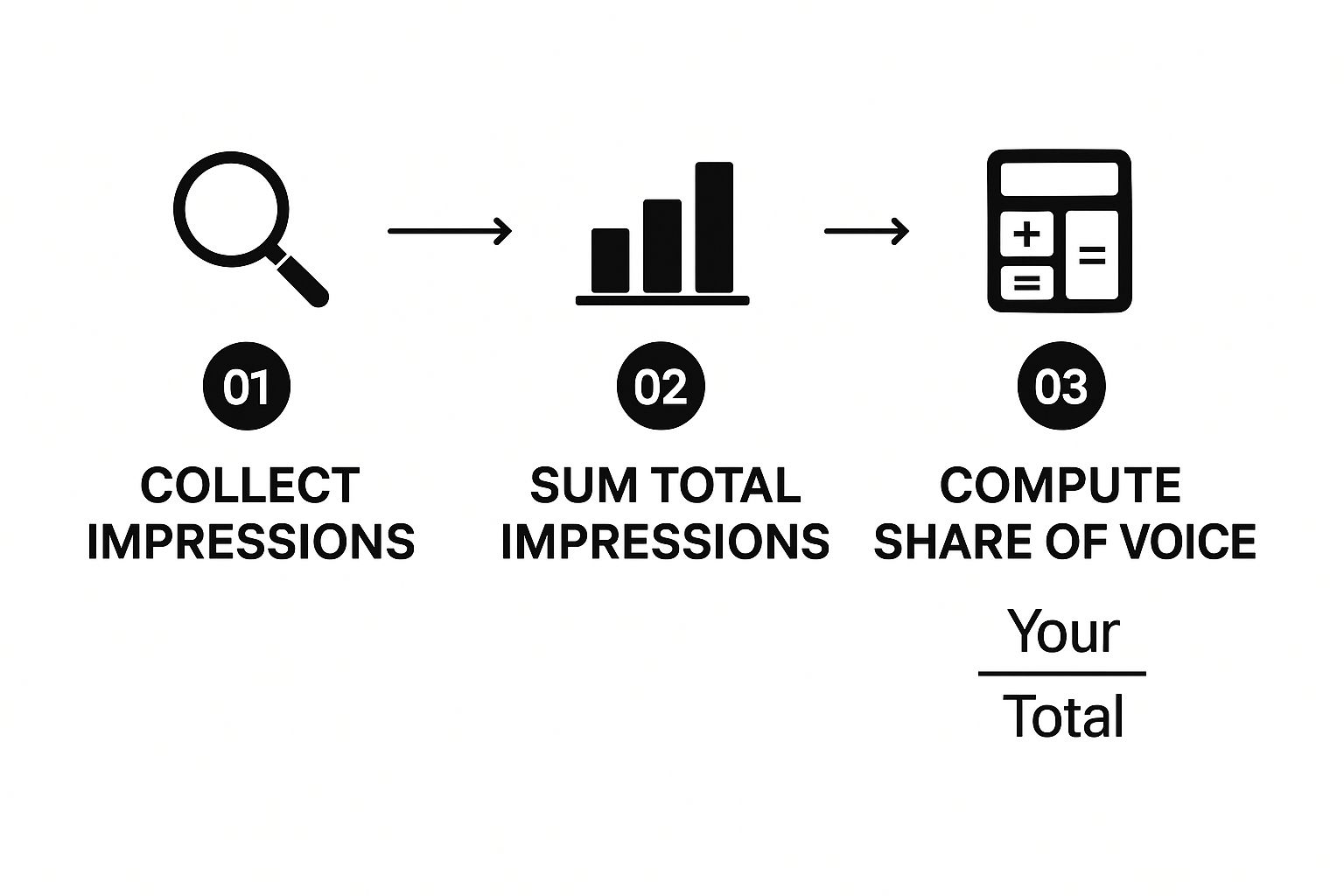SEO & LLM Share of Voice: Your Complete Guide to Digital Dominance
Understanding SEO Share of Voice in Today's Digital Landscape

Think of search results as a crowded town square where every brand is shouting to attract an audience. In this noisy environment, your SEO share of voice (SoV) is a measure of how effectively your message cuts through the chatter. It's not just about showing up; it's about how many potential customers hear you compared to your competitors.
Simply paying for a bigger ad isn't enough to dominate the search results. Earning organic visibility requires a sharp understanding of where you stand. Share of voice is a crucial business intelligence metric that shows you exactly how you measure up against others fighting for the same eyeballs.
Beyond Rankings: A True Competitive Benchmark
Tracking your SEO share of voice is much more telling than just watching a handful of keyword rankings. Hitting the top spot for a single term is a win, but SoV paints the entire picture of your market position. It helps you answer the big-picture questions:
- How visible is our brand for the topics that actually drive our business?
- Which competitors are capturing more attention, and in what areas are we falling behind?
- Are there any overlooked topics where we could step in and become the authority?
This approach moves the goalposts from chasing isolated keyword victories to making a strategic evaluation of your overall market presence. It transforms raw data into a clear guide for making smarter marketing decisions that lead to real growth.
The Evolving Search Environment
The "town square" of search is always in flux. Google maintains its powerful position with a 90% share of the global search market, making it the primary stage for any brand. At the same time, how people search is changing. Voice search now makes up over 20% of all queries on the Google App, which means strategies need to account for more natural, conversational questions.
This market dominance, combined with new search behaviors, directly influences how you should work to grow your share of voice. Discover more essential search statistics to see how the field is changing.
The Next Frontier: LLM Share of Voice
The very idea of visibility is expanding. The next stage isn't just about appearing on a list of blue links; it's about being featured in answers generated by AI. With the growth of Large Language Models (LLMs) like ChatGPT, a new path to discovery has opened.
Your LLM share of voice measures how often your brand appears in these AI-powered conversations. If these models don't mention you, you're invisible to a growing segment of your audience. This represents a major shift in how people find information, making it a vital new metric for any forward-thinking brand.
How to Calculate Your SEO Share of Voice: Step-by-Step Method
Calculating your SEO share of voice is more than just counting your rankings; it's about understanding your true visibility in the market. Think of it like this: just knowing you have pieces on a chessboard doesn't tell you if you're winning. You need to know which squares they control. A weighted calculation gives you this strategic view by factoring in the real-world value of each search position.
The Core Ingredients for Calculation
Before you can start, you need to gather a few essential data points. This isn't just about compiling a long list of keywords but collecting specific metrics that reflect your competitive environment.
You will need:
- A defined list of your most important commercial and informational keywords.
- The monthly search volume for each of these keywords.
- Your current ranking position for every term.
- The ranking positions of your key competitors for the same set of keywords.
A Weighted Approach to Measurement
With your data gathered, you can calculate a weighted SoV. This method recognizes that a #1 ranking is significantly more powerful than a #10 ranking. For example, the top result on Google commands an average click-through rate (CTR) of 27.6%, while the tenth result scrapes by with just 2.4%.
Here's the step-by-step process:
- Assign CTR Weight: Assign a CTR percentage to each ranking position on the first page. You can use industry benchmark data or, even better, your own click-through rates from Google Search Console for higher accuracy.
- Calculate Visibility Score: For each keyword, multiply its monthly search volume by the CTR weight of your ranking position. This gives you an estimated number of clicks, or your "visibility score," for that term.
- Sum Total Visibility: Repeat this process for all your tracked keywords and add the scores together to find your total visibility score. You'll need to do the same for each of your competitors.
- Compute Your SoV: Add your score and all your competitors' scores to find the total market visibility. Your SEO share of voice is your total visibility score divided by the market's total visibility score, expressed as a percentage.
This process flow chart simplifies the calculation into three core stages.

This visual highlights that the fundamental goal is to compare your impression volume against the total available impressions in your market.
While the weighted CTR model is the most insightful, it's not the only way to measure SoV. The best method often depends on how much time you have and the level of precision you need.
Here's a look at how different calculation approaches stack up.
SEO Share of Voice Calculation Methods Comparison
Comparison of different calculation approaches with their pros, cons, and best use cases
| Method | Complexity | Accuracy | Best For | Time Required |
|---|---|---|---|---|
| Simple Rank Count | Low | Low | Quick, high-level snapshots or tracking a small list of "must-win" keywords. | Minimal |
| Weighted CTR Model | Medium | High | In-depth competitive analysis, strategic planning, and performance reporting. | Moderate |
Ultimately, while a simple rank count can give you a quick pulse check, the weighted CTR model provides a far more realistic and actionable picture of your actual standing in the search results.
Essential Tools for Tracking Your SEO Share of Voice
Trying to track your SEO share of voice by hand is a losing game. The sheer volume of data makes it impossible to get an accurate read. Today, the challenge is even bigger because you're no longer just competing for spots on a search engine results page (SERP)—you're also fighting for visibility inside AI conversations.
Tools for Classic SERP Visibility
For measuring your performance in traditional search, established SEO suites are the go-to solution. These platforms are built to track keyword rankings, estimate organic traffic, and analyze competitor backlink profiles. They give you a solid, reliable map of your territory on search engines like Google.
These tools calculate your share of voice based on metrics like impressions and click-through rates for the keywords you care about. They are essential for understanding your position in the familiar battle for the top results on a search page.
The New Frontier: LLM Share of Voice Tools
However, traditional SEO tools have a massive blind spot: they can't see into AI-generated answers. This is where a new metric, LLM share of voice, becomes essential. It measures how often and how favorably your brand appears in the responses from models like ChatGPT.
A new battleground requires a new kind of tool. Platforms like SELLM function as a specialized LLM share of voice calculator. They go beyond SERP data to monitor your brand's presence in AI-powered chat, analyzing not just the frequency of mentions but also the context and sentiment. This gives you a clear picture of your visibility where older analytics simply can't reach.
To navigate this dual landscape, you need the right set of tools. The table below compares some of the leading platforms for both traditional and AI-driven share of voice tracking.
Top SEO Share of Voice Tracking Tools
Detailed comparison of leading tools with pricing, features, and suitability for different business sizes
| Tool | Starting Price | Key Features | Best For | Free Trial |
|---|---|---|---|---|
| SELLM | $29 / month | LLM visibility tracking, brand mention analysis, citation share monitoring across ChatGPT, Gemini, etc. | Brands and marketers focusing on Generative Engine Optimization (GEO) and visibility in AI answers. | Yes, free plan available |
| Semrush | $129.95 / month | All-in-one suite: keyword tracking, backlink audits, competitor research, classic SoV reports. | Businesses of all sizes needing a comprehensive digital marketing and traditional SEO platform. | Yes, 7-day trial |
| Ahrefs | $99 / month | Powerful backlink index, keyword explorer, rank tracking, site audits. | SEO professionals and agencies who need deep backlink data and competitive intelligence for SERPs. | No, but offers free tools |
As you can see, traditional powerhouses like Semrush and Ahrefs are masters of the SERP, while newer tools like SELLM are designed specifically for the AI-driven conversational world. A truly effective strategy often requires a combination of both.
Adapting Is Not Optional
Treating both SERP and LLM visibility as priorities is no longer a choice. The global SEO market, valued at $82.3 billion in 2023, is expected to surge to $143.9 billion by 2030. This growth is fueling intense competition, with 58% of SEOs confirming that rivalry has significantly increased due to AI's influence. These statistics highlight a rapidly evolving field.
In this high-stakes environment, ignoring your brand's presence in AI answers is like turning your back on a huge segment of your market. Success demands a strategy that performs in both arenas. You can learn more about how to appear in AI outputs in our guide on AI search optimization.
Ultimately, a complete toolkit for measuring SEO share of voice must cover both domains. You need foundational tools for the structured world of SERPs and a specialized platform for the conversational world of AI. Only by measuring your visibility across both can you build a resilient and forward-thinking strategy for market leadership.
Interpreting Your Data: From Numbers to Strategic Insights

Calculating your SEO share of voice gives you a number, but a raw percentage without context is just noise. Think of it as a score on a leaderboard; it tells you where you stand, but it doesn't tell you how to win the game. To turn that data into a real strategy, you need to understand the story it tells about your place in the market.
What Your SoV Percentage Really Means
Your share of voice figure is a snapshot of your competitive power. Each percentage range points toward a different strategic playbook.
- Low SoV (Under 10%): You are the challenger. Taking on market leaders directly is a quick way to burn through your budget. Your best move is to focus on niche opportunities, like untapped long-tail keywords or specific topics that bigger competitors are ignoring.
- Medium SoV (10-30%): You are an established contender with solid ground. The goal here is twofold: defend your current rankings while actively looking for growth opportunities. Analyze which competitors are stealing clicks and for which keywords, then plan your counter-attack.
- High SoV (Over 30%): You are the market leader. Your primary job is to protect your position and watch for threats. Complacency is your biggest risk. You must constantly monitor for new competitors and emerging channels that could disrupt your dominance.
Beyond the SERP: The Rise of LLM Share of Voice
Assuming your work is done after checking traditional search results is a major oversight. A new, critical metric has entered the arena: LLM share of voice. This measures how visible your brand is within answers generated by AI assistants like ChatGPT. A high Google ranking doesn't help if an AI model recommends your competitor instead.
This is where most standard tools fall behind. A specialized LLM share of voice calculator is necessary to see this hidden part of your market presence. It shows whether you are being mentioned, ignored, or even misrepresented in these important AI conversations. Ignoring this data is like trying to navigate a new city with a map from ten years ago.
Understanding your visibility means looking at both where you appear and how. For instance, 75% of users never go past the first page of search results, making top positions essential. The way you appear is also important; featured snippets earn the highest click-through rate at 42.9%. As AI continues to change search, being the brand mentioned in a generative response is the new premium real estate. Discover the data behind modern search behavior to fine-tune your approach.
LLM Share of Voice: Winning in the AI-Powered Search Era
For years, businesses have battled for visibility on a crowded page of search results. But what happens when that search page is replaced by a direct conversation with an AI? That's where a new form of visibility matters.
Think of it like this: traditional SEO gets you listed in the phone book. Getting mentioned by an AI is like being recommended by a trusted local expert. When a user asks an AI assistant for advice, your brand's presence in that answer is its LLM share of voice.
The New Competitive Blind Spot
This shift creates a major blind spot for most businesses. Your standard SEO tools are great at telling you where you rank on Google, but they go completely dark when it comes to AI-generated answers. They simply can't see what's happening inside the chat window.
A top ranking on Google offers zero guarantee that your brand will be mentioned by models like ChatGPT or Claude. This means you could have a strong traditional SEO share of voice but be a ghost in this critical new channel.
Without the right tools, you're essentially flying blind, completely unaware of how often you're mentioned, in what context, or how you measure up against competitors in these AI-driven conversations.
Measuring Your Presence in AI Conversations
To track this new type of visibility, you can't rely on old methods. You need a specialized LLM share of voice calculator. This isn't about counting keyword positions on a page; it's about monitoring brand mentions inside the AI's actual responses.
Platforms like SELLM are designed for exactly this. They provide clear data on how your brand is performing inside these AI conversations. For example, here's a look at a dashboard built to track brand performance within AI models:
This kind of tool turns what seems like an abstract conversation into hard data. You can see how often your brand is mentioned and how that compares to your competitors. The takeaway is that AI visibility is no longer a black box—it's a number you can track, manage, and work to improve.
What Influences AI Recommendations?
So, how do AI models decide who to recommend? They act like a diligent researcher, reading through massive amounts of information from their training data to form an opinion. They don't just pull from one website; they look for patterns and weigh different signals to figure out which brands are authoritative and relevant.
Key factors that influence their recommendations include:
- Consistent brand mentions across reputable websites, articles, and online forums.
- Positive sentiment and context in public reviews and discussions.
- Clear associations between your brand and certain industry problems or topics.
- Structured data that helps the AI easily understand your products, services, and expertise.
Building a strong presence in these areas is how you establish digital authority today. You can learn more about the specific signals that influence these models in our guide to LLM SEO. Taking a deliberate approach is the only way to ensure AI models view your brand as a credible and helpful resource worth recommending to their users.
SELLM: The Complete LLM Share of Voice Calculator and Tracker
While standard SEO tools are vital for tracking your rank on search result pages, they offer no visibility into how your brand appears within AI-powered assistants. This is the gap that SELLM fills, as the first platform built to measure your presence in Large Language Models and function as a dedicated LLM share of voice calculator.
Think of SELLM as your intelligence unit inside AI conversations. The system monitors your brand mentions across many AI models, but it does much more than just tally them up. It examines the frequency of mentions, the context surrounding them, the sentiment of the AI's recommendation, and your competitive positioning within the same answer.
This level of detail gives you a true measurement of your SEO share of voice in this new environment. It answers the questions that older tools were never designed to ask: Is the AI speaking about your brand positively? Are you recommended alongside your main competitors, or are you being ignored completely?

From Measurement to Strategic Action
SELLM converts abstract numbers into a straightforward action plan. You can create monitoring campaigns that deliver continuous updates on your performance in this important new channel. This allows you to:
- Benchmark against competitors by tracking how often they are mentioned for the same group of questions.
- Understand query triggers by seeing the exact questions that lead to mentions of your brand.
- Pinpoint influential content by tracing AI recommendations back to the probable source articles.
This detailed tracking provides the direct feedback you need to adjust and improve your strategy.
Decoding AI-Specific Performance
The platform's dashboard shows metrics that you won't find in traditional analytics tools. Instead of CTR and impressions, you will work with data points specific to LLMs, like Citation Share—the percentage of AI-generated lists in your field that include your brand. You also get clear reports on sentiment scores and how relevant your brand is in the context of the answer.
Understanding this information tells you exactly where to direct your energy. For example, a low citation share for high-intent questions points to a clear opportunity to produce more focused and authoritative content. This approach shifts you from making guesses to making informed decisions about your AI visibility.
Businesses are already applying these insights to get ahead of the curve. By seeing which types of content influence AI recommendations, they can improve existing assets and produce new ones that have a higher chance of being cited. This is more than just measurement; it's about actively managing your brand's story and winning in the new world of AI-driven answers.
Proven Strategies to Dominate Your SEO Share of Voice
Knowing your SEO share of voice is one thing; actually growing it is another. Boosting this number isn't about guesswork. It requires a focused plan to find opportunities your competitors have missed, produce content that's genuinely better, and build your authority across the channels that matter.
Start with a Competitive Keyword Gap Analysis
Before you write a single new post, you need a battle plan. A keyword gap analysis is your strategic map, revealing the valuable keywords your competitors are ranking for where you have zero visibility. This isn't about casting a wide net; it's about pinpointing the exact search terms where they are winning and you aren't even on the field.
Focus on finding untapped opportunities like:
- High-intent long-tail keywords that show a user is close to making a decision.
- Niche topics that your larger, more established competitors have deemed too small to bother with.
Winning these less-contested keywords can deliver quick traffic gains and build the momentum needed to tackle more difficult terms later.
Create Authoritative Content for Humans and AI
Today, your content has two audiences: the people reading it and the AI models that generate answers for them. The goal is to build such deep authority that you satisfy both. Instead of just chasing individual keywords, think in terms of topic clusters. This means creating a central "pillar" page on a broad subject, then supporting it with several "cluster" pages that explore related subtopics in detail.
This structure demonstrates your expertise to search engines and provides the kind of comprehensive information that AI language models depend on. A brand that shows it has deep, first-hand knowledge is far more likely to be cited as a source. For some brands, publishing content with more depth and data than the competition has increased SoV by as much as 60% in less than a year.
Amplify Your Authority with Strategic Link Building
Even the most brilliant content can go unnoticed without a signal boost. Link building is that amplifier. Think of each high-quality backlink as a public vote of confidence, telling both search engines and AI that other credible sources vouch for your information.
The key is to prioritize quality over quantity. You can earn these endorsements by guest posting on authoritative sites in your industry, finding and fixing broken links on other websites, or creating unique content with original data or graphics that people naturally want to reference and link to. These signals are vital for improving your position in search results and for being recognized as a credible source by AI.
Improving your share of voice is a continuous cycle of analysis, creation, and amplification. Each strategy reinforces the others, creating a powerful effect that strengthens your market presence. But these tactics are only half the story; you must consistently track your progress to confirm your efforts are paying off. You can learn more about monitoring brand performance to turn your hard work into measurable success.
Your Action Plan for SEO Share of Voice Success
Achieving a strong SEO share of voice isn't about reaching a finish line; it's an ongoing practice of smart moves and quick adjustments. Instead of drowning in data, you can use a straightforward framework to make steady gains in both traditional search results and AI-generated answers.
A Practical Growth Framework
Think of your strategy as a series of quarterly sprints. This rhythm gives you enough time to see real changes take hold, while keeping you nimble enough to pivot when needed.
- Months 1-3 (Analyze & Plan): This first quarter is your intelligence-gathering phase. Dive deep into a competitive keyword gap analysis to find the topics and questions your rivals aren't answering. At the same time, measure your starting point to establish a baseline for both your SERP and LLM share of voice.
- Months 4-6 (Execute & Build): With a solid plan, it's time to build. Develop comprehensive topic clusters around the opportunities you uncovered and launch strategic link-building campaigns to boost your site's authority. The goal is to create content that serves both curious humans and AI models.
- Ongoing (Measure & Adapt): Keep a constant watch on your key metrics. Think of a drop in your share of voice as an early warning flare—it's a clear signal that a competitor is gaining ground or that it's time to refresh your approach.
Prioritizing Your AI Visibility
While a traditional SEO share of voice is essential, ignoring your presence in AI answers is a significant misstep. Your visibility on Google doesn't guarantee an AI assistant will recommend you.
Think of it this way: ranking on Google gets you into the library, but it doesn't ensure the librarian (the AI) will recommend your book. To truly grasp your position in the market, you need a specialized LLM share of voice calculator.
This isn't just a nice-to-have feature; it's a fundamental piece of any modern visibility plan. Tracking these mentions gives you the direct feedback required to create content that AI models trust and recommend.
Ready to get the complete picture of your visibility and prepare your strategy for what's next? Start tracking your LLM Share of Voice with Sellm today and discover where your brand truly stands.